Table of Contents
Practical Geometry Class 7 Extra Questions Maths Chapter 10
Extra Questions for Class 7 Maths Chapter 10 Practical Geometry
Practical Geometry Class 7 Extra Questions Very Short Answer Type
Question 1.
State whether the triangle is possible to construct if
(a) In ΔABC, m∠A = 80°, m∠B = 60°, AB = 5.5 cm
(b) In ΔPQR, PQ = 5 cm, QR = 3 cm, PR = 8.8 cm
Solution:
(a) m∠A = 80°, m∠B = 60°
m∠A + m∠B = 80° + 60° = 140° < 180°
So, ΔABC can be possible to construct.
(b) PQ = 5 cm, QR = 3 cm, PR = 8.8 cm
PQ + QR = 5 cm + 3 cm = 8 cm < 8.8 cm
or PQ + QR < PR
So, the ΔPQR can not be constructed.
Question 2.
Draw an equilateral triangle whose each side is 4.5 cm.
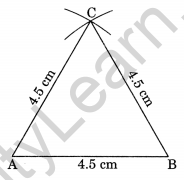
Solution:
Steps of construction:
(i) Draw AB = 4.5 cm.
(ii) Draw two arcs with centres A and B and same radius of 4.5 cm to meet each other at C.
(iii) Join CA and CB.
(iv) ΔCAB is the required triangle.
Question 3.
Draw a ΔPQR, in which QR = 3.5 cm, m∠Q = 40°, m∠R = 60°.

Solution:
Steps of construction:
(i) Draw QR = 3.5 cm.
(ii) Draw ∠Q = 40°, ∠R = 60° which meet each other at P.
(iii) ΔPQR is the required triangle.
Question 4.
There are four options, out of which one is correct. Choose the correct one:
(i) A triangle can be constructed with the given measurement.
(a) 1.5 cm, 3.5 cm, 4.5 cm
(b) 6.5 cm, 7.5 cm, 15 cm
(c) 3.2 cm, 2.3 cm, 5.5 cm
(d) 2 cm, 3 cm, 6 cm
(ii) (a) m∠P = 40°, m∠Q = 60°, AQ = 4 cm
(b) m∠B = 90°, m∠C = 120° , AC = 6.5 cm
(c) m∠L = 150°, m∠N = 70°, MN = 3.5 cm
(d) m∠P = 105°, m∠Q = 80°, PQ = 3 cm
Solution:
(i) Option (a) is possible to construct.
1.5 cm + 3.5 cm > 4.5 cm
(ii) Option (a) is correct.
m∠P + m∠Q = 40° + 60° = 100° < 180°
Question 5.
What will be the other angles of a right-angled isosceles triangle?
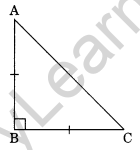
Solution:
In right angled isosceles triangle ABC, ∠B = 90°
∠A + ∠C = 180° – 90° = 90°
But ∠A = ∠B
∠A = ∠C = \(\frac { 90 }{ 2 }\) = 45°
Hence the required angles are ∠A = ∠C = 45°
Question 6.
What is the measure of an exterior angle of an equilateral triangle?
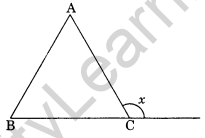
Solution:
We know that the measure of each interior angle = 60°
Exterior angle = 180° – 60° = 120°
Question 7.
In ΔABC, ∠A = ∠B = 50°. Name the pair of sides which are equal.
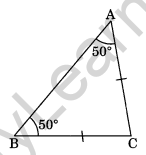
Solution:
∠A = ∠B = 50°
AC = BC [∵ Sides opposite to equal angles are equal]
Hence, the required sides are AC and BC.
Question 8.
If one of the other angles of a right-angled triangle is obtuse, whether the triangle is possible to construct.
Solution:
We know that the angles other than right angle of a right-angled triangle are acute angles.
So, such a triangle is not possible to construct.
Question 9.
State whether the given pair of triangles are congruent.

Solution:
Here, AB = PQ = 3.5 cm
AC = PR = 5.2 cm
∠BAC = ∠QPR = 70°
ΔABC = ΔPQR [By SAS rule]
Practical Geometry Class 7 Extra Questions Short Answer Type
Question 10.
Draw a ΔABC in which BC = 5 cm, AB = 4 cm and m∠B = 50°.

Solution:
Steps of construction:
(i) Draw BC = 5 cm.
(ii) Draw ∠B = 50° and cut AB = 4 cm.
(iii) Join AC.
(iv) ΔABC is the required triangle.
Question 11.
Draw ΔPQR in which QR = 5.4 cm, ∠Q = 40° and PR = 6.2 cm.
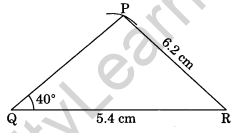
Solution:
Steps of construction:
(i) Draw QR = 5.4 cm.
(ii) Draw ∠Q = 40°.
(iii) Take R as the centre and with radius 6.2 cm, draw an arc to meet the former angle line at P.
(iv) Join PR.
(v) ΔPQR is the required triangle.
Question 12.
Construct a ΔPQR in which m∠P = 60° and m∠Q = 30°, QR = 4.8 cm.
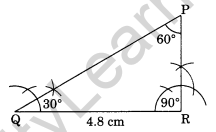
Solution:
m∠Q = 30°, m∠P = 60°
m∠Q + m∠P + m∠R = 180° (Angle sum property of triangle)
30° + 60° + m∠R = 180°
90° + m∠R = 180°
m∠R = 180° – 90°
m∠R = 90°
Steps of construction:
(i) Draw QR = 4.8 cm.
(ii) Draw ∠Q = 30°.
(iii) Draw ∠R = 90° which meets the former angle line at P.
(iv) ∠P = 180° – (30° + 90°) = 60°
(v) ΔPQR is the required triangle.
Practical Geometry Class 7 Extra Questions Higher Order Thinking Skills [HOTS] Type
Question 13.
Draw an isosceles right-angled triangle whose hypotenuse is 5.8 cm.
Solution:
Right angled triangle is an isosceles triangle
Each of its acute angles = \(\frac { 90 }{ 2 }\) = 45°
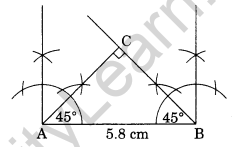
Steps of construction:
(i) Draw AB = 5.8 cm.
(ii) Construct ∠A = 45° and ∠B = 45° to meet each other at C.
(iii) ∠C = 180° – (45° + 45°) = 90°
(iv) ΔACB is the required isosceles right angle triangle.
Question 14.
Construct a ΔABC such that AB = 6.5 cm, AC = 5 cm and the altitude AP to BC is 4 cm.
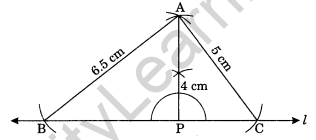
Solution:
Steps of construction:
(i) Draw a line l and take any point P on it.
(ii) Construct a perpendicular to l at P.
(iii) Cut AP = 4 cm.
(iv) Draw two arcs with centre A and radii 6.5 cm and 5 cm to cut the line l at B and C respectively.
(v) Join AB and AC.
(vi) ΔABC is the required triangle.
Question 15.
Construct an equilateral triangle whose altitude is 4.5 cm.
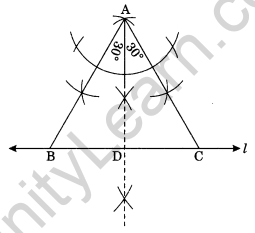
Solution:
Steps of construction:
(i) Draw any line l and take a point D on it.
(ii) Construct a perpendicular to l at D and cut AD = 4.5 cm.
(iii) Draw the angle of 30° at on either side of AD to meet the line l at B and C.
(iv) ΔABC is the required equilateral triangle.







